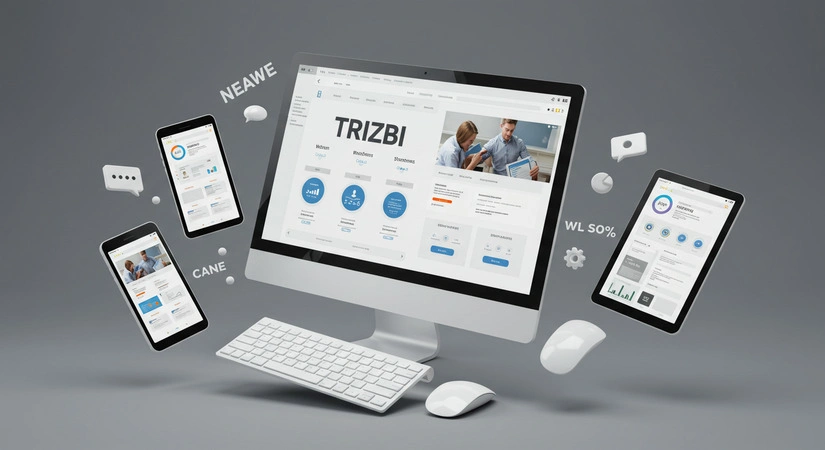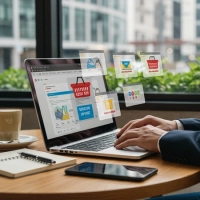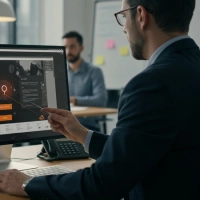
Why Is Building a B2B Site Now Indispensable?
In the past, B2B sales were usually conducted through field visits, phone calls, trade shows and printed catalogs. However, with the globalizing market, accelerating business processes and the entry of Generation Y into the business world, habits have changed radically. Today, B2B buyers, like B2C consumers, prefer to do online research, compare products and place orders on their own. As a result of these changing dynamics, having a B2B e-commerce site offers invaluable advantages to your business:
- 24/7 Uninterrupted Trading Opportunity: Your business never closes! Your customers can examine your products, get a price quote or place an order whenever they want, regardless of time zone or geographic location.
- Revolution in Operational Efficiency: Time-consuming and error-prone processes such as manual order entries, telephone price inquiries, and e-mail traffic are left behind.
- Reducing Costs: There are significant reductions in items such as field sales team travel expenses, cost of printed marketing materials, and operational workload.
- Market Access and New Business Opportunities: You can easily expand beyond your local borders into national and even international markets.
- Smart Data-Based Decisions: Who orders how much? Which products are popular in which regions? What are your customers' on-site behaviors? With detailed reporting and analytics capabilities that provide instant answers to all these questions, you can make more accurate and strategic decisions for the future of your business.
- Improved Customer Experience: You can increase customer loyalty and establish long-term business relationships by offering special pricing, personalized product catalogs, fast order history tracking and instant stock information.
- Competitive Advantage: In a digital market, you gain a significant advantage over your competitors who have no or insufficient online presence.
Step by Step Guide to Success in Creating a B2B Site
Building a successful and sustainable B2B website is not just about installing software. It is a comprehensive project that requires strategic planning, the right technology selection, and continuous optimization. Here is the step-by-step guide:
1. Comprehensive Needs Analysis and Strategic Planning
This is the basis of the project. The more detailed analysis you do, the more successful the site will be.
- Define Your Target Audience and Their Purchasing Process: Clarify who your B2B customers are (dealers, distributors, retailers, corporate buyers, etc.). How do their purchasing processes work? At what stages do they need information? Who is involved in the decision-making process? The answers to these questions will shape the structure and content of your site. For example, while wholesale pricing and inventory information may be a priority for a dealer, project-based bidding processes and technical details may be more important for a corporate buyer.
- Map Your Workflows and Identify Digitization Opportunities: How do your current order-taking, approval, invoicing, shipping, returns, and customer support processes work? Which steps of these processes can be digitized and automated? This analysis plays a key role in your B2B software selection and integration strategy. For example, you can significantly reduce the workload of your accounting department by automating manual invoicing processes.
- Competitive Analysis and Differentiation Strategy : What kind of features do your competitors' B2B e-commerce sites offer? What are their strengths and weaknesses? In what areas can you make a difference? For example, you can stand out by offering a special personalization feature or faster shipping options that your competitors don't have.
- Set KPIs (Key Performance Indicators): How will you measure the success of your site? Set concrete, measurable goals, such as an X% increase in sales volume, a Y% increase in new dealership participation, or a Z% decrease in customer service costs. These goals will guide you through each phase of the project.
2. Choosing the Right Platform and Technology
Choosing the technological infrastructure that will form the basis of your B2B site is one of the most critical steps of the project. This choice directly affects the performance, scalability, security and future development potential of your site.
Ready-made B2B Solutions or Custom Software Development?
- Ready-made Solutions (SaaS B2B Platforms): SaaS (Software as a Service) platforms designed specifically for B2B needs, such as Trizbi, usually offer faster setup, lower startup costs, and regular updates. Thanks to their modular structure, you can start by selecting the features you need and expand later. It can be an ideal starting point for small and medium-sized businesses.
- Custom Software Development: If your business has very niche and unique business processes, custom software development may be considered when ready-made solutions on the market are inadequate. However, this option requires a higher cost and a longer investment.
- Integration Capability: When choosing a B2B software, one of the most important criteria is that it can seamlessly integrate with your existing ERP, CRM, accounting, inventory management, shipping and payment systems. These integrations ensure data consistency, eliminate manual data entry and automate workflows. For example, when an order is entered into the system, it should be automatically transferred to your ERP, the stock should be updated and the invoicing process should begin.
- Customizability and Flexibility: It is important to choose a platform that can be easily customized and adapt to the dynamic structure of your business and future growth goals. It should offer B2B-specific flexibility such as price lists specific to different dealer groups, personalized product catalogs, role-based authorizations.
- Security and Performance: Strong security measures (SSL certificates, firewalls, data encryption, etc.) are essential for protecting customer data, payment information, and trade secrets. Additionally, ensuring your site operates quickly and without interruption, even under high traffic, is vital for customer experience and SEO.
3. User Experience (UX) and Design-Oriented Approach
A B2B website should focus on functionality as much as it does on aesthetics. A user-friendly design will allow your customers to easily navigate your site, find what they are looking for, and transact seamlessly.
- Navigation and Ease of Use: In B2B sites with complex product catalogs or numerous categories, a simple and understandable menu structure, effective search bars and advanced filtering options are essential for customers to quickly access the product or information they are looking for.
- Mobile Compatibility (Responsive Design): Today, a significant portion of B2B buyers access the site from mobile devices (tablets, smartphones). The ability to view and use your site seamlessly on all devices (responsive design) is a critical requirement for both customer satisfaction and SEO.
- Professional and Corporate Identity-Appropriate Design: The visual design of your site should reflect the corporate identity of your business and give a sense of trust and professionalism. Clean lines, correct use of brand colors and an uncluttered layout leave a positive first impression on visitors.
- Clear and Comprehensible Product Information: B2B buyers need detailed information. Product images, technical specifications, user manuals, certificates, stock information and pricing should be presented clearly.
4. Integration of Core B2B Features
What really sets a B2B site apart from a standard B2C site are the functions specific to business-to-business commerce.
- Customer-Specific Pricing and Catalogs: Ability to offer special pricing, discount rates, or product catalogs that only certain customers can view, to different customer groups or dealers.
- Bulk Ordering and Fast Reordering Options: B2B customers often place large volume orders or frequently reorder the same products. Give them the ability to place bulk orders or easily reorder past orders with just one click.
- Advanced Payment and Credit Options: Support standard payment methods such as credit cards and wire transfers, as well as B2B-specific payment models such as in-house credit accounts, deferred payment options, and purchase orders (POs).
- Role-Based Authorization and User Management: Allow employees from different departments of a company or with different authorization levels to use the site with different permissions. For example, a purchasing specialist may place orders, while a manager may need to approve orders.
- Order Tracking and History: It is important for customers to be able to instantly track the status of their orders, access cargo information, and easily access their past orders.
- CRM and ERP Integration: These integrations are essential to provide personalized service by collecting customer data in a central system and to effectively manage all the resources of your business.
5. Content Creation and SEO Optimization (Your Site’s Digital Showcase)

Even if you design a great B2B website, your efforts can be in vain if potential customers can’t find you. This is where SEO (Search Engine Optimization) comes into play.
- Keyword Research and Strategy: What are your B2B customers searching for on Google or other search engines? Identify keywords and long-tail variations like “B2B software prices,” “industrial parts suppliers,” “wholesale textile solutions.” Use these words naturally in your site’s titles, descriptions, product text, and blog content.
- Quality and Detailed Content: B2B buyers need comprehensive information in the decision-making process. Explain in detail not only the features of your products, but also their benefits, areas of use, integration capabilities and place in the industry. Inform your potential customers and demonstrate your expertise with rich content such as blog posts, case studies, white papers, industry reports, and customer testimonials.
- Technical SEO Optimization: Technical details such as your site's fast loading (page speed), mobile compatibility, secure connection (SSL certificate), clean URL structures, correct meta descriptions and title tags are very important for search engine rankings.
- On-Site and Off-Site SEO: Increase user experience and SEO value by establishing logical connections between your content (internal linking). Increase your site's authority by getting backlinks (external links) from other reliable sites in your industry.
- Image and Video Optimization: Use high-quality product images and promotional videos. Compress image files and describe them with alt text to both improve SEO and accessibility.
6. Testing and Continuous Optimization
Continuously testing and optimizing your site before and after it goes live is essential to success.
- User Acceptance Testing (UAT): Ask potential B2B customers or internal users to test your site. Gather feedback to address gaps in usability, functionality, and flow.
- Performance Tests: Test how your site performs under heavy traffic, load times and error rates.
- Monitor with Analytics Tools: Use tools like Google Analytics to regularly track your site traffic, customer behavior, conversion rates, and which pages are most popular. This data will guide you to continually improve your site.
- A/B Tests: Run A/B tests on different headlines, images, or call-to-action buttons to determine which versions perform better and continually optimize your site.
- Building a B2B Site: An Investment, a Partnership
Creating a B2B website is not just about creating a digital presence, it is also a strategic investment in the future of your business. Choosing the right B2B solution partner in this process will directly affect the success of your project. An experienced software company will not only provide the technical infrastructure, but will also guide you in developing the right strategies, combined with your industry knowledge.
Remember, digital transformation is not a one-time process, but an ongoing journey. The B2B website you build will be the digital heart of your business and will constantly evolve with the right maintenance.
As Trizbi , we offer powerful, scalable and user-friendly B2B software and e-commerce solutions designed for the specific needs of your business. If you are looking for a reliable partner in your digitalization journey, contact us today to discover our solutions that will take your business to the next level.
For more information, you can also check out our content titled What is a B2B Program?























